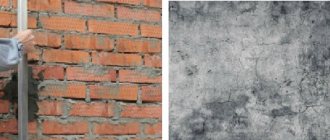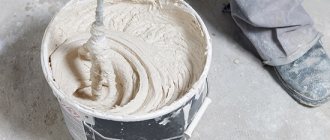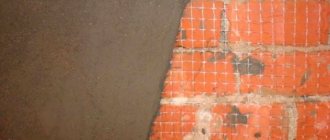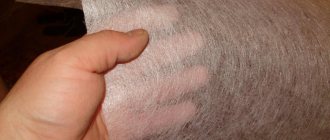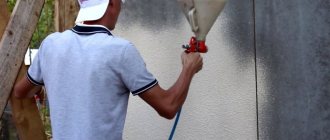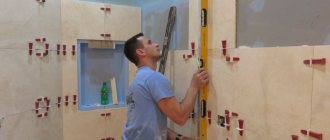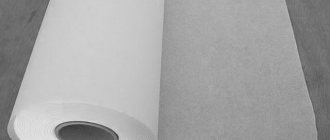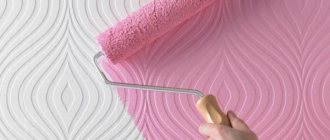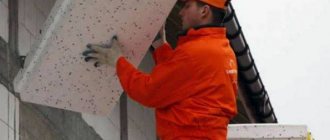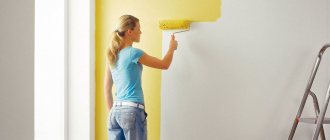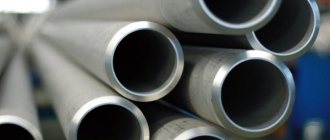Features of application
Fiberglass is used to secure finishing putty or other finishes. This thin and lightweight material can be used at any angle and on any surface. In addition, it improves the surface structure and ensures its wear resistance.
How and why to glue under putty
The fiberglass must be glued under the putty, otherwise after removing the finishing material the cobwebs will follow it.
Fiberglass is glued as follows:
- Preparatory work. Before gluing the web, you need to prepare the wall. To do this, putty is applied to the drywall, which hides irregularities, joints, etc. It is important to consider the following rules:
- Before filling, the walls should be cleaned of dirt;
- the places where irregularities were sealed should not be convex. To do this, you can use surface grinding;
- if there are still bulges, you can apply the putty again;
- Before applying fiberglass, the wall should be cleaned of dirt and sanded.
- Gluing fiberglass:
- the first layer should be glued from the corner;
- The glue itself must be applied to the wall, and only then the cobweb should be glued;
- It is better to cut the required number of sheets in advance, since gluing must be done continuously to avoid visible joints;
- then the excess glue and air are smoothed out with a spatula;
- use a knife to remove excess material;
Is it possible to glue fiberglass under wallpaper?
Fiberglass is a reinforcing material that is used for painting surfaces. It can also be used under wallpaper, but before doing this, be sure to treat the surface.
What density of the material should be
Painting fiberglass is made from quartz sand. It is sold in rolls of 50 meters and a width of 1 meter. For wall finishing, the density of the material should be 25-50 g/m2.
Where else is it used?
Fiberglass has a wide range of uses. It is used to make:
- Plumbing parts: dry closet, shower stalls.
- Sports goods - oars, ski poles.
- Creation of boxes and containers for household purposes.
- Medical products - fillings, prostheses.
- Tubes for household use - antennas, various holders, etc.
- Electrical products - indicators, fuses.
Let's start painting
After the glue has hardened, the treated wall must be painted. If you do not intend to putty it to give it a perfectly smooth surface, then use water-based paints. They adhere perfectly to painting fiberglass and at the same time favorably emphasize its fleecy structure. For work, use a medium-nap roller, soaking it generously in paint. It shouldn't be half-dry when you move it along the wall. The paint should be applied in a thick layer, abundantly saturating all the recesses. For the best effect, cover the wall one at a time - first with horizontal movements, then with vertical ones. This will give an even layer that will evenly cover even the most difficult areas.
Pasting fiberglass walls and ceilings
Fiberglass can be glued to any surface. With its help, you can increase the strength of putty and plaster and prevent the formation of cracks. It is used before painting.
Surface preparation
Before you begin work, the walls and ceiling must be puttied with a finish. This will help avoid unevenness and cracks, and will have a positive effect on the finishing result. Before gluing the material, the entire surface is treated with a primer.
Only after this can you proceed directly to pasting.
Master class on how to glue cobwebs to the ceiling
First you need to dilute the glue, which is sold in the form of a dry mixture. The gluing itself is carried out in several stages:
- Pre-cut several pieces of fiberglass. It is better to cut a larger size so that there is enough left for joining the parts.
- The glue is applied to the material itself and on the sides, as well as on the ceiling.
- After gluing the canvas, use a roller to remove the bubbles. This is done from the middle to the edges.
- After the original color of the web has become darker, you can glue the next canvas.
- It is glued to the previous canvas, after which all excess is removed with a knife. This area is then treated with a spatula so that the seams are invisible. And this is done with all previous canvases.
After completing the work, the room should be closed so that the glue dries faster. Also, sunlight should not reach there.
Application for wallpaper: how to glue correctly
Gluing fiberglass under wallpaper is practically no different from any other type of finish. Before starting work you must:
- Remove old finishes and clean walls.
- Remove screws, nails, etc.
- Putty the walls, paying attention to cracks and chips.
- Use sandpaper to smooth the surface.
- Prime the walls.
Further actions are similar to the previous ones.
Is it necessary to use fiberglass under the putty mixture?
Most renovation specialists are faced with the problem of cracks along the joints on drywall surfaces.
Even a special mesh cannot always prevent the appearance of cracks, because they appear under the strong influence of shrinkage of the house or temperature changes.
To prevent this from happening, you can use fiberglass (in ordinary speech it is called cobweb), it is actually fiberglass. But this is not like glass wallpaper (braided threads), but a pressed material. With its help, you can strengthen the base well and prevent cracks from appearing.
To improve the technical performance of this material, it is recommended to apply a layer of putty on it.
This article will tell you how to use fiberglass and how to properly prepare it for coating with putty mixture.
Recommendations
In order for the work to be done efficiently, and the result to be pleasing to the eye for a long time, you must follow the recommendations:
- The maximum length of the canvas should not exceed two meters, otherwise problems with gluing may arise.
- Before gluing, you need to determine the front part of the material.
- During work, you need to use rubber gloves, a respirator and goggles to avoid the ingress of small particles.
- Fiberglass should be glued at a room temperature of 18 to 25 degrees above zero.
- It is better to start work on the opposite side of the door.
Fiberglass is an excellent material that will help quickly and efficiently remove any unevenness from the surface. By following all the rules and technology of use, you will be able to create a unique and neat room design.
Additional Information:
Good evening!
We are going to glue the fiberglass web before painting the walls.
Builders are trying to persuade you not to glue it with a special glue for glass wallpaper, as the glue is not moisture-resistant and during subsequent puttying, the fiberglass may come off and produce bubbles.
They offer the following technology instead of glue:
drown the fiberglass immediately in putty (i.e. apply one layer and, without allowing it to dry, attach the fiberglass to it and coat it with a second layer).
This way the web will not be held on by the glue, but will be in the middle of the putty.
- The first sheet, no matter on the ceiling or walls, is glued from the corner of the structure, the material is applied to the glue layer and leveled by hand. After this, take a wallpaper spatula and use it to expel air and excess glue, if any, from under the fiberglass. In this case, you should move from the middle to the edges, without missing a single centimeter of the area. If you don't know what a spatula looks like, look at the photo below.
A distinctive feature of this type of painting is the need to apply several layers. You cannot apply two layers at once: it will warp or peel off in layers in a fairly short time, exposing the base with putty. Failure to comply with the technology for using paint compositions can reduce the service life of the paint.
However, it is unlikely that you will be able to paint such a surface several times.
- Pre-cut several pieces of fiberglass. It is better to cut a larger size so that there is enough left for joining the parts.
- The glue is applied to the material itself and on the sides, as well as on the ceiling.
- After gluing the canvas, use a roller to remove the bubbles. Gluing fiberglass on the walls and putting it on the nuances? This is done from the middle to the edges.
- After the original color of the web has become darker, you can glue the next canvas.
- It is glued to the previous canvas, after which all excess is removed with a knife. This area is then treated with a spatula so that the seams are invisible. And this is done with all previous canvases.
Whether it will work out exactly or not does not matter. Let us note one important detail. If cutting occurs on a plasterboard structure, the cardboard can be damaged, and in this case we will definitely get a crack at the cut site.
To avoid this, we advise you to first blunt the tip of the knife blade, for example, on a screed or brick. A dull blade will cut the canvas easily, but will not harm the cardboard. After we cut through the canvases, remove excess from the last one, pry it with a blade and pull out a strip from the first one:
When applying glue, we go a little onto the already glued sheet. A new piece of canvas is applied to this part of the surface and glued to the wall, overlapping the first part. The area where two sheets overlap is easily smoothed with a spatula. Next, the overlap of two sheets of fiberglass is cut with a knife.
It can be clerical.
The excess tolerance at the bottom is cut off with a knife, under the ruler. The fiberglass laid on the wall needs to be coated once again with adhesive on top. If there are missing areas (not glued), they can be easily identified by their distinguishable shade.
A well-impregnated fabric has a uniform color.
Advice! Surprisingly, the “web” has an outside and a back side; professionals identify it by eye, and you need to read the label on the roll, which will show the necessary information. In most cases, rolls are rolled upside down.
It is necessary to paint the fiberglass spider web twice, that is, apply two layers of paint. How to apply decorative putty to walls video? It is worth noting that the time between application of layers should be at least 12 hours. To roll a seam, you need to use a “wing”; if you do it with a roller, the result will not be optimal.
In principle, these are all the features of painting such a finishing material.
Paint selection
Glass fiber canvas can be painted with materials that are suitable for glass wallpaper. Water-based paints are most suitable for this purpose; they do not affect the performance qualities of the main material. Similar paints do not have a nasty odor and are not harmful to humans. It contains only environmentally friendly elements (polymer materials, water, targeted additives). There are several types of water-dispersion paints, they are described below.
Acrylic based paints
These paints are the most common; they have many good qualities. Easy application and quick drying, together with a low price, are the main positive qualities. Paints can be applied to fiberglass canvas or wallpaper, the coating will be resistant to friction and water. The materials adhere perfectly to the surface and give an attractive decorative look. A large number of paint brands are sold in white; they can be tinted to any shade.
Latex based paints
Such materials have a higher price. These are water-dispersion based
, without chemicals, not harmful and suitable even for children's rooms. The composition contains real latex, which makes the coating more resistant to water.
Surfaces with latex-based paints can sometimes be washed or wiped with a damp cloth. This material is quite economical and makes it possible to obtain reliable results. If acrylic materials give a matte film, then latex materials give a matte, semi-gloss, glossy film.
Silicone paints
Enamels containing silicone are not afraid of dirt, this is their main advantage. There are no aggressive chemical components here either, thanks to this the material is completely non-hazardous. Silicone paints, as a rule, will last up to 25 years without losing their external gloss, but their price is much higher among water-dispersion compositions. The material is considered moisture-resistant, vapor-permeable, heat-resistant, and is not exposed to mold, mildew, or ultraviolet radiation.
What you need for work
Gluing fiberglass is much easier than wallpaper, it takes little time, but you can rest assured of the quality of the finish and not be afraid that due to shrinkage of the house or temperature changes, repairs will soon be needed again. Let's find out what kind of material this is, how it “works” and what is needed to install it.
Fiberglass
Fiberglass is a non-woven fiberglass material that looks like a thin “blotter”. It is produced by pressing rather than interweaving fibers. By itself, it does not have strength and breaks easily, but after gluing to the surface, provided that the technology is strictly followed, it forms a reinforcing coating that is very resistant to deformation.
Fiberglass is sold in rolls of 45-50 meters with a width of 1 meter, and may differ in density. It has a front and back side, which must be taken into account during installation.
For high-quality finishing of walls and ceilings prone to cracking, it is recommended to choose a material with a density of at least 40 g/sq.m.
The price of the material is low; depending on the density, a roll can cost from 300 to 1000 rubles. This is not something to skimp on, as repeated repairs resulting from cracks will cost much more.
Auxiliary materials and tools
Of course, the fiberglass itself will not stick to the wall; this requires special glue and a standard set of tools:
- Glue sometimes comes complete with fiberglass. If this is not the case, buy glue for glass wallpaper - no other glue, including PVA or composition for heavy wallpaper, is suitable;
Ready-made glue for fiberglass
Note. When calculating the required amount of glue, multiply the consumption stated for glass wallpaper by 1.5-2, since fiberglass has high absorbency. In addition, the instructions require that the already glued sheets be coated with adhesive on top.
- To apply glue, which has a fairly thick consistency, to the surface it is best to use a wide brush;
- It is convenient to smooth fiberglass with a special plastic wallpaper spatula, which experts call a “shark fin”;
Wallpaper spatula and lines along which it expels air from under the canvas
- You will also need a sharp painting knife and a long ruler or wide spatula for joining the canvases and trimming overlaps.
Criteria for choosing glass wallpaper for painting
The peculiarities of glass wallpaper production sometimes make it difficult to choose. It may be impossible to visually distinguish high-quality products from defective ones. Knowledge of selection methods does not help either. For example, the density and thickness of the material can be increased by impregnation. But this will definitely have an effect during the pasting process - the canvas tears, deforms, loses elasticity, and sometimes decreases in size. As a result, the clarity of the drawing is disrupted.
The ideal solution to the problem is to cut a piece from the roll, stick it on a solid base (not advisable on the wall, because if the quality is good, it will take a long time to peel it off), let it dry, and paint it. The test is completed by pressing the spatula onto the trellises. If they are not deformed or change their appearance, the quality is high.
If this is not possible, the choice should be made according to the following parameters:
- density;
- composition;
- class;
- pattern.
Density. The density criterion determines the durability of the trellis. There is a direct relationship here: the denser, the longer the service life.
Wallpaper with a density of over 100 g/cm2 is considered high quality. But this is the lower limit of the indicator. You need to focus on the figure of 150 g/m2 (European manufacturers have a standard value of 145 g/m2). Deeply patterned fiberglass fabric (jacquard) can be even heavier, up to 220 g/m2.
But here, as with any rule, there are exceptions. For the ceiling, 25 g/m2 is enough - that’s how much smooth cobwebs weigh. But for walls, the web canvas should have an indicator of 45-50 g/m2.
Compound. Many buyers underestimate such a selection criterion as composition. But in vain. The strength and durability of the finish depend on the indicator. At the same time, deviation of the ratio of 70% fiberglass to 30% impregnation in any direction worsens the consumer characteristics of the finishing material.
Information about the composition should be on the insert. Its absence should alert the buyer.
Class. On the insert you can also find the class of wallpaper (Russian manufacturers indicate the grade, which is the same thing). You need to buy first class fiberglass trellises. When purchasing second-rate decor, the density must be at least 100 g/m2.
Pattern. For the ceiling you need smooth wallpaper - cobweb. For the walls, the pattern is chosen depending on the taste of the owners (“matting”, “herringbone”, “drops”). At the same time, a pattern with greater depth can be repainted more times - the pattern will be preserved.
Installation technology
In the process of self-repair, many questions often arise.
In our case, the most important ones are the following:
- How to prepare a surface for fiberglass reinforcement;
- How to glue it correctly;
- Is it necessary to putty the fiberglass before finishing?
We will answer in this order.
Preparing walls for reinforcement
Before gluing fiberglass to a wall or ceiling, the surface must be leveled with putty (see Leveling walls with putty according to all the rules). This stage can be skipped only if it has already been puttied earlier and the coating is smooth and durable.
Small cracks with a thickness of no more than 1 mm are allowed.
- Large cracks on the plastered surface are opened and sealed in several steps with putty or a special compound for seams;
- The joints between sheets of plasterboard (see How to putty joints of plasterboard according to technology) and other sheet facing materials, as well as the places where they are attached to the frame, are also puttied, and the seams are necessarily reinforced with serpyanka;
Plasterboard ceiling with sealed joints
- After the “patches” have dried, the entire surface is leveled with putty and sanded until a flat plane is obtained;
Advice. Before applying a continuous layer of putty, mark on a drawing or a specially taken photograph where the seams are. When you start gluing the fiberglass, they should not coincide with the joint lines of the canvases.
- Before gluing the fiberglass, the walls are cleaned of dust using a vacuum cleaner and primed.
In a word, all the activities are similar to those carried out in preparation for wallpapering. At this stage, it is very important to achieve almost perfect evenness of the walls so that the fiberglass lays on them without folds or tears.
Gluing fiberglass
First of all, measure the area of the surfaces to be glued to determine the required amount of materials.
Advice. Please note that fiberglass is glued with an overlap, so you need to add 5-10% to the data obtained.
You can buy ready-made glue, but it costs much more than the dry mixture. If you want to save money, take the powder, but dilute it strictly according to the manufacturer's instructions on the packaging.
Before handling fiberglass, wear long sleeves and long pants, a hat, and gloves. A respirator or gauze bandage won't hurt either. The fact is that when working with this material, particles of fiberglass get into the air, which cause itching and sneezing.
Work order:
- Roll out the roll and cut the sheets to the required length. In the case of pasting the walls, they will be equal to their height with a slight overlap, and it is easier to finish the ceiling with canvases one and a half to two meters long, especially if you work alone, without an assistant.
The photo shows the process of gluing the ceiling in small pieces
- Starting from the corner, apply a thick layer of adhesive to the wall with a brush in a strip of a little more than a meter. There is no need to lubricate the entire surface at once - the glue dries quickly.
- Glue the first sheet of fiberglass close to the corner. First, press it lightly with your hands, and then smooth it along the entire length with a wallpaper spatula from the middle to the edges, as is usually done when gluing paper wallpaper.
- Excess canvas in the corner, on the floor or ceiling is trimmed with a paint knife along a ruler.
- Now take the brush again and coat the already pasted canvas with glue on top, completely saturating it. Uncoated areas can be easily identified by color - they are lighter than the main surface.
- The second and subsequent canvases are glued in the same way, but with an overlap on the previous one. After leveling with a spatula and removing air and excess glue from under the sheet, a ruler is applied to the middle of the overlap and both sheets are cut along it with a knife. The cut strips of both sheets are removed, and the resulting joint is coated with glue and pressed with a spatula in a longitudinal motion.
Trimming the joint using a spatula
- Having reached the corner, measure the distance to it from the edge of the last glued strip and cut a piece of fiberglass of the appropriate width, taking into account the overlap. The fact is that if the corner is not perfectly even, the material on it will still tear, so it is better to immediately make an even cut.
This way the entire area is covered. Do not forget to offset the joints of the sheets relative to the joints between the sheets of drywall, otherwise a crack may appear in this place.
At least a day must pass until the walls are completely dry, during which drafts should not be allowed in the room.
Finishing
Finally, let’s answer the last question: does fiberglass need to be puttied before painting, decorative plaster or wallpapering?
It is absolutely necessary, at least for the following reasons:
- Wallpaper does not adhere well to such a surface, especially if it is heavy - vinyl or non-woven;
- The texture of fiberglass, which is not decorative, will be visible under a layer of paint;
- A fiberglass-reinforced base has an increased ability to absorb moisture, which leads to serious overuse of wallpaper glue or paint, which will have to be applied in several layers.
Final ceiling putty
Therefore, it is advisable to putty the walls before the final stage of finishing with finely dispersed finishing compounds, having previously primed them. Since they have already been leveled at the preparatory stage, it will not take much time and will not require a large consumption of materials: it is enough to apply 1-2 thin layers of finishing putty.
Preparing fiberglass for painting: important recommendations
Deciding on the need to putty the surface causes some disagreement among craftsmen. The web has a beautiful structure, which many people want to preserve, but in this case the paint consumption will be significant, since it will be necessary to paint the fiberglass without putty in 4-5 layers. In addition, joints will be noticeable on the surface, no matter how perfectly they are made.
Another reason why it is necessary to putty fiberglass is the likelihood of tiny particles of glass entering the air that are harmful to human health. A layer of plaster will completely eliminate this drawback.
Whether or not to putty a surface with fiberglass is up to everyone to decide for themselves.
To putty the surface of fiberglass, use any good quality finishing mixture on a polymer or gypsum basis. The composition is applied after the surface has completely dried. The putty should be applied in two layers with a break of 24 hours. The first layer must have a thickness of no more than 2 mm, the second must completely cover the initial base. After drying, the surface is rubbed with sandpaper to give it a smooth structure. Before painting or wallpapering, the web must be re-primed and the surface must be completely dry.
How to glue fiberglass to walls under putty: what is it for?
In the process of finishing concrete ceilings and walls, it is often necessary to seal cracks and irregularities. To ensure that the screed is strong and does not crack, the base of such a surface is reinforced with a painting “web”. To achieve the quality of the process, before carrying out work, you need to figure out how to glue fiberglass to walls under putty and what it is needed for. In the previous publication, the material on preparing the ceiling for painting deliberately did not touch upon the issue of working with canvas. This topic was planned to be discussed in a separate article, which is what we bring to your attention.
Work procedure
To avoid errors during work and to avoid starting it again, it is important to follow all technical rules.
This is not a very simple procedure, but you can do it yourself.
Preliminary work
The preliminary stage takes place in the following algorithm:
Installation work
The technology for gluing cobwebs will be described below:
Fiberglass is cut inside and outside the corners. In these places the material will tear anyway, but if it is not cut, it will tear unevenly.
Another thing you need to know is that the joint between two sheets should not be done at the joints of drywall. If this is not observed, the web will burst.
It is important to remember where the joints of the drywall and the seams of the fiberglass are, so that they cannot be joined.
The coating dries in about a day. During this period, you cannot ventilate the room; all drafts must be excluded.
After drying, surface finishing can be done further.
Fiberglass has an outer and inner side. If you have experience working with such material, then the sides can be immediately distinguished from each other. But, if this cannot be done, then all this information must be indicated on the packaging. Usually the roll is rolled so that the wrong side is inside the roll.
Puttying
It is necessary to putty the surface because:
Putty on fiberglass is carried out according to the following algorithm:
To make the entire overall structure stronger, it is definitely necessary to use fiberglass. You can’t skip the puttying stage either.
This procedure is no different from putting putty on any other surface.
Source
Material characteristics
This material contains glass: during the manufacturing process it is melted, drawn into threads and twisted into fibers - the basis for producing canvas using weaving. Along with tensile strength, glass threads are characterized by elasticity, which protects the finished fabric from deformation. At the final stage of manufacturing, the “web” is treated with a special impregnation that increases its stability. The density of the finished material is in the range of 25-65 g/m2.
Advantages of fiberglass:
- Environmental Safety. To make the material, only natural ingredients are used that do not cause allergic reactions.
- Strength and durability. The canvas copes with both mechanical and temperature influences.
- Does not collect dust. Electrostatic inertness prevents the attraction of light debris to the finishing surface.
- Fire safety. Exceptional fire resistance, the material is used for finishing corridors of large buildings through which people are evacuated in case of fire.
- Reinforcing abilities. The web-trimmed base provides strength for the finishing layer.
- Biological inertia. Microorganisms, including mold, do not grow in fiberglass. This is facilitated by the fact that glass fibers are not afraid of water and do not rot in conditions of constant humidity.
- Vapor permeability. There is no “clogging” of reinforced bases.
- Excellent interaction with most building materials.
♥See also the photo gallery on the website “Furniture set with a bathroom cabinet”
Despite the great similarities, reinforcing fiberglass and glass wallpaper are two materials with different purposes.
The main disadvantage of the “cobweb” is the inconvenience due to the small glass particles that appear when cutting the canvases. It is recommended to work in protective clothing, gloves, goggles and a respirator.
Where is the “cobweb” used?
Why do you need fiberglass:
- Reinforcement of walls and ceilings. With its help, you can strengthen plasterboard, concrete, brick and other foundations indoors. This is especially true in cases where the surface is being prepared for painting. Thanks to fiberglass reinforcement, the base is well leveled, without the threat of subsequent cracking.
- Corrosion protection. The presence of anti-corrosion characteristics in glass fibers allows them to be used to protect metal pipelines.
- Production of high quality building materials. Floor coverings and wall panels are often reinforced with fiberglass. In addition, it is part of bitumen mastics, which are indispensable when installing soft roofs.
- Arrangement of waterproofing protection and drainage.
Well-known manufacturers of painting fiberglass webs
To select a quality material, you should pay attention to fiberglass fabrics made by well-known manufacturers. The companies Wellton, Spektrum, Oskar, Samtex have proven themselves well. Depending on the density of the material, the price of fiberglass for painting will be 800-1500 rubles. per roll.
The Swedish manufacturer Oskar offers high-quality products that are characterized by good wear resistance and affordable prices. You can tear or cut the web only on purpose, with a sharp object. To paint such Oscar fiberglass, you will need a minimal amount of paint, even when painting without using putty. You can buy Oskar fiberglass from 1200 rubles. per roll.
Samtex's reinforcing material is in demand for protecting surfaces from cracks. The web is durable, hypoallergenic, wear-resistant and has good energy-saving properties. You can buy such a universal material for decorating walls and ceilings from 800 rubles. per roll.
Fiberglass from the Oskar company can be purchased from 1200 rubles. for one roll.
When performing painting, repair and construction work, fiberglass from the Finnish company Wellton is very popular. The web is characterized by increased fire safety, resistance to humidity, high temperatures and aggressive environments, high density, hypoallergenicity and a long period of operation. The cost of the material is 1000-1200 rubles. per roll.
The Dutch company Spektrum specializes in the production of high-quality fiberglass at an affordable cost. The material can be applied to any surface. A special place in the product range is given to dense fiberglass mats, which provide reliable protection of the wall surface from the formation of cracks and other damage. The price of fiberglass starts from 600 rubles. per roll.
What is fiberglass?
- What is fiberglass for the ceiling and how to stick it
The answer to the question, what is fiberglass for ceilings...
To watch photos "
In the construction industry, the following types of “cobwebs” are most often used:
- 25 g/cm2. The best fiberglass for ceilings for painting, which is facilitated by its light weight and strength. The ceiling “cobweb” has low absorbency, which saves paint material.
- It is recommended to purchase fiberglass for personal needs from the following manufacturers:
- Wellton. This Finnish material can withstand numerous repaints.
- Oskar. A less expensive Russian analogue that can be repainted several times with little material consumption. Domestic fiberglass TechnoNIKOL also has similar qualities.
- Spectrum. This Dutch company offers fiberglass in various densities.
- Nortex. Chinese manufacturer offering high-quality “spider web”. However, its choice is limited only to the universal variety (50 g/cm2).
♥Please see the photo gallery on the website “Photos of bathroom furniture design”
How to glue fiberglass to a concrete ceiling yourself
To strengthen a concrete ceiling, the so-called “ceiling web” with a density of 25 g/cm2 is usually used. Optimal working conditions are of great importance, since it is recommended to use fiberglass at an air temperature of +15-25º and a humidity of no more than 60%.
Surface preparation
Before gluing fiberglass to the ceiling for painting, its surface must be completely cleaned of whitewash, wallpaper and old putty - a bare concrete slab should remain.
If base defects are detected, they must be eliminated. All protrusions are knocked down with a pick, and the depressions are sealed.
It is better to lay a leveling layer of starting putty on the concrete surface.
Padding
Primer. After the ceiling has dried, it is impregnated with a deep penetration primer. For example, acrylic compounds. Thanks to this, the ceiling surface acquires the necessary adhesion for subsequent application of the adhesive. The primer should be allowed to dry (30-40 minutes).
Preparation of glue. For this, it is recommended to use special compounds, since it will not be possible to properly glue fiberglass for painting with conventional wallpaper materials. PVA glue holds fiberglass well, but subsequently its surface may become covered with yellow spots. It is best to use a special adhesive for fiberglass canvas and glass wallpaper, which is sold in dry or ready-made form (as a rule, good brands of painting canvas are equipped with mounting adhesive from the same manufacturer). A pack of dry composition is diluted in a ten-liter bucket of clean warm water: this volume is enough to glue a “cobweb” with an area of 50 m2.
Cutting and gluing
Having measured the length and width of the room, then cut the required number of pieces of “cobweb”. This is not difficult to do, since the material is sold in rolls for convenience. The length of the strips is taken with some margin (about 10 cm). The same applies to the width - here you need to take into account the fact that the strips are glued with a slight overlap (up to 20 mm). When cutting, you need to wear a respirator, safety glasses and gloves to avoid getting sharp particles on the skin of your hands, eyes and respiratory organs.
The first strip is mounted from the edge of the ceiling, having previously coated this area with a generous layer of glue (the canvas absorbs a lot of it). For convenience, it is recommended to cut a line the width of the strip along the entire length of the surface. Having placed the edge of the canvas along the line, it is necessary to smooth it from the center in all directions, expelling air bubbles and excess glue. This operation is performed with a plastic wallpaper spatula. Excessive force should not be used when pressing the tool so that the fiberglass does not tear (at this stage it is vulnerable).
How to properly glue fiberglass strips
The next strip is glued next to the first with a slight overlap (it is immediately cut with a sharp knife, removing excess parts). For the quality of finishing, it is recommended to additionally coat the joint areas with glue. As you glue the fiberglass, it is important to maintain the continuity of the process by gluing the sheets one after another.
The painting canvas has an inner and outer side - it is advisable not to confuse them. The outer side is twisted inside the roll (smooth to the touch).
After the entire ceiling is sealed, excess pieces of material are trimmed along its entire perimeter. Next, the area of the laid canvas is covered with a layer of the same glue (you need to dilute it a little with water). The fiberglass canvas for putty should dry well (1-2 days).
Features of finishing
The painting cloth creates a unique texture on the surface of the ceiling: therefore, it is advisable to putty the fiberglass “cobweb” before painting. 1-2 layers of a soft gypsum solution (Satengypsum) or ready-made (acrylic) mixture are enough. Such a ceiling should be sanded very carefully, without exposing the fiberglass. For painting, use conventional water-based, acrylic or latex paint, which is applied with a fabric roller in two layers.
You can skip the putty, but in this case you will have to use 5-6 layers to paint, since fiberglass has different absorbing characteristics.
How to remove glue from spider webs
Excess adhesive must be cleaned off at the joints with a spatula; its location should create a right angle of 90 degrees. Excess glue on the surface can be removed by simply wiping it with a clean cloth. Work is performed in a respirator, protective clothing and gloves.
Excess glue on the surface can be removed by simply wiping it with a clean cloth.
The article described how to glue fiberglass correctly. This is a simple process that you can handle on your own. The main thing is to choose a suitable adhesive solution.
